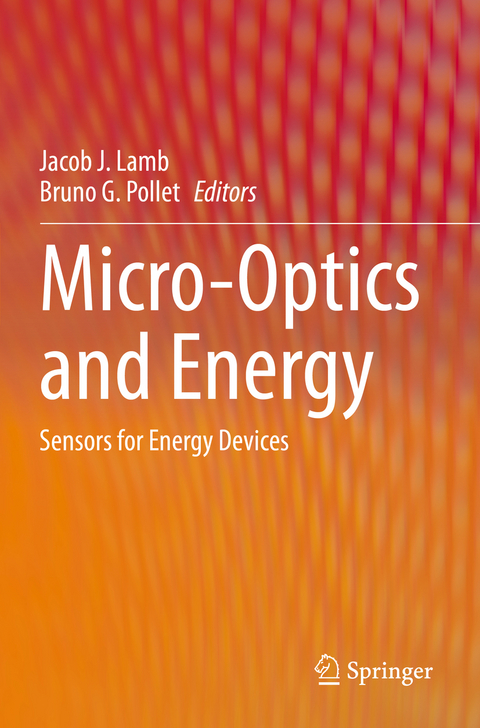
Micro-Optics and Energy
Springer International Publishing (Verlag)
978-3-030-43678-0 (ISBN)
lt;p>Bruno G. Pollet is a full Professor of Renewable Energy at the Norwegian University of Science and Technology (NTNU) in Trondheim. He currently leads the "NTNU Team Hydrogen". He is a Fellow of the Royal Society of Chemistry (RSC, UK), an Associate Fellow of the Institution of Chemical Engineers (IChemE, UK) and Board of Directors' member of the International Association for Hydrogen Energy (IAHE). He is currently Visiting Professors (VP) at the University of Ulster (UK) and the University of the Western Cape (RSA), and was "Professeur des Universités Invité" at the Université de Franche-Comté (France) and a VP at the University of Yamanashi, Professor Watanabe's labs (Japan). His research covers a wide range of areas in Electrochemistry, Electrochemical Engineering, Electrochemical Energy Conversion and Sono-electrochemistry (Power Ultrasound in Electrochemistry) from the development of novel hydrogen & fuel cell materials, CO2 conversion, to water treatment/disinfection demonstrators & prototypes. He was a full Professor of Energy Materials and Systems at the University of the Western Cape (RSA) and R&D Director of the National Hydrogen South Africa (HySA) Systems Competence Centre. He was also a Research Fellow and Lecturer in Chemical Engineering at The University of Birmingham (UK) as well as a co-founder and an Associate Director of the Birmingham Centre for Hydrogen and Fuel Cell Research. He has worked for Johnson Matthey Fuel Cells Ltd (UK) and other various industries worldwide as Technical Account Manager, Project Manager, Research Manager, R&D Director, Head of R&D and Chief Technology Officer. He was awarded a Diploma in Chemistry and Material Sciences from the Université Joseph Fourier (Grenoble, France), a BSc (Hons) in Applied Chemistry from Coventry University (UK) and an MSc in Analytical Chemistry from The University of Aberdeen (UK). He also gained his PhD in Physical Chemistry in the field of Electrochemistry and Sonochemistry under the supervision of Professors J. Phil Lorimer & Tim J. Mason at the Sonochemistry Centre of Excellence, Coventry University. He undertook his PostDoc in Electrocatalysis at the Liverpool University Electrochemistry group led by Professor David J. Schiffrin.
Affiliations
Hydrogen Energy and Sonochemistry research group, Department of Energy and Process Engineering, Faculty of Engineering & NTNU Team Hydrogen, Norwegian University of Science and Technology (NTNU), Trondheim, NorwayJacob J. Lamb obtained both his B.Sc. and M.Sc. in Biochemistry at the University of Otago, New Zealand, where he worked in a research laboratory with Associate Professor Julian Eaton-Rye and Associate Professor Martin Hohmann-Marriott. He moved to Norway in 2013 to undertake a PhD in Biotechnology under the supervision of Associate Professor Martin Hohmann-Marriott, which he completed in June 2016. From 2016 to 2018, he undertook postdoctoral research in biogas and sensor technologies with Professor Dag R. Hjelme and Associate Professor Kristian M. Lien at NTNU. Since 2018, he has worked as a senior researcher at NTNU on a variety of projects within the fields of biology, bioenergy, renewable energy, sensor technologies and energy storage His areas of expertise include photosynthesis, microbiology, biological and biochemical techniques, electronics and programming, renewable energy, energy storage, sensor technologies, optical spectroscopy and process engineering. His research motivation is to improve renewable energy sources, increase sustainability within agricultural and aqua cultural industries, develop technologies for climate change mitigation as well as develop ways to measure, analyse, and optimize biological processes.
Affiliations
Department of Electronic Systems & Department of Energy and Process Engineering & ENERSENSE NTNU
Section 1: Optical Properties for Sensors.- Chapter 1.1: Introduction to Optical Sensors.- Chapter 1.2: Light Properties and Sensors.- Section 2: Optical Sensor Measurements.- Chapter 2.1: Temperature and Humidity Measurements.- Chapter 2.2: Hydrogen Gas Measurements.- Chapter 2.3: Sensor Fusion.- Section 3: Energy Production and Storage.- Chapter 3.1: Hydrogen Fuel Cells and Water Electrolysers.- Chapter 3.2: Ultrasound-Assisted Electrolytic Hydrogen Production.- Chapter 3.3: Low Grade Waste Heat to Hydrogen.- Chapter 3.4: Liquid Air Energy Storage.- Chapter 3.5: Hydrogen and Biogas.- Chapter 3.6: Lifetime Expectancy of Lithium-ion Batteries.- Section 4: Micro-Optical Sensors in Energy Systems.- Chapter 4.1: Thermal Management of Lithium Ion Batteries.- Chapter 4.2: Reverse Electrodialysis Cells.- Acknowledgements.
| Erscheinungsdatum | 13.06.2021 |
|---|---|
| Zusatzinfo | XIII, 207 p. 49 illus., 46 illus. in color. |
| Verlagsort | Cham |
| Sprache | englisch |
| Maße | 155 x 235 mm |
| Gewicht | 349 g |
| Themenwelt | Naturwissenschaften ► Chemie ► Physikalische Chemie |
| Schlagworte | embedded sensors • Energy Storage • Humidity sensing • Hydrogen electrolysers • Hydrogen Fuel Cells • lithium ion batteries • micro sensors • Optical fiber • Optical sensors • Reverse electrodialysis • Temperature sensing |
| ISBN-10 | 3-030-43678-0 / 3030436780 |
| ISBN-13 | 978-3-030-43678-0 / 9783030436780 |
| Zustand | Neuware |
| Haben Sie eine Frage zum Produkt? |
aus dem Bereich


